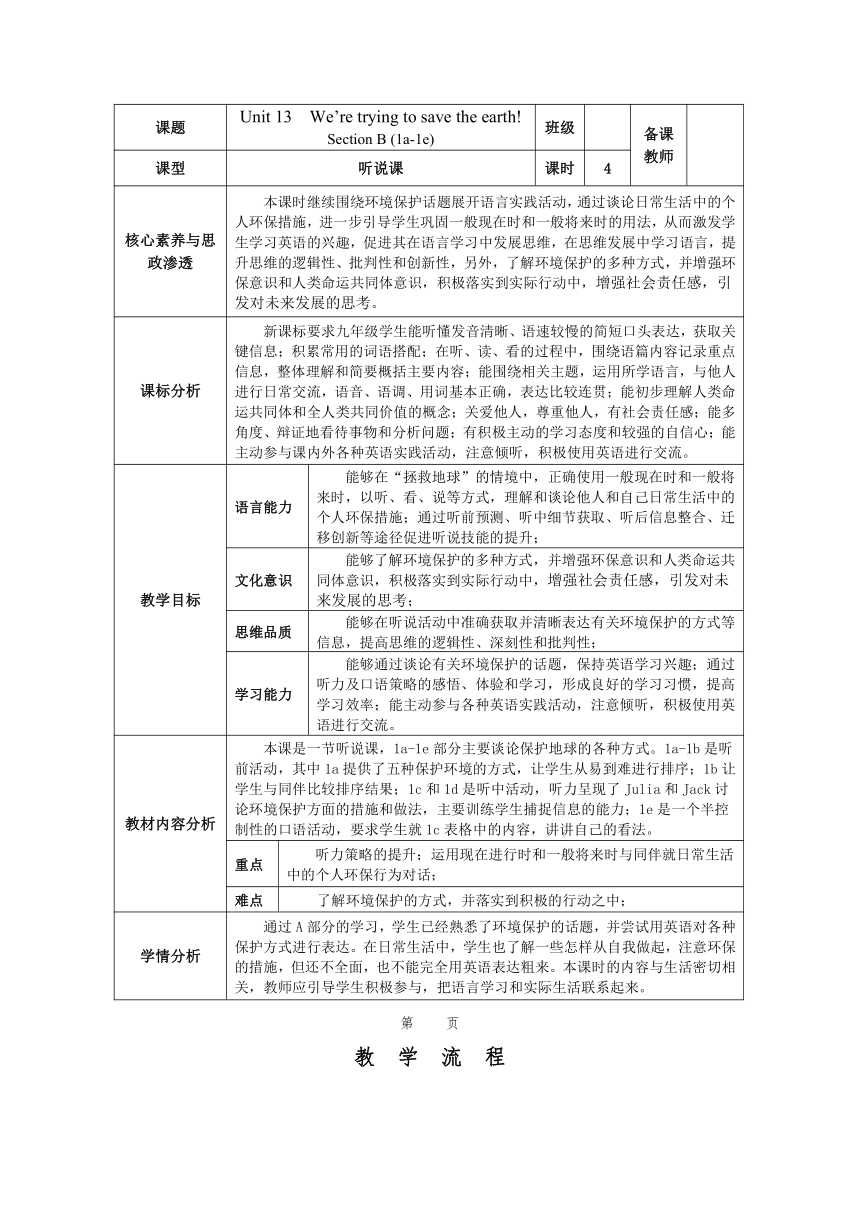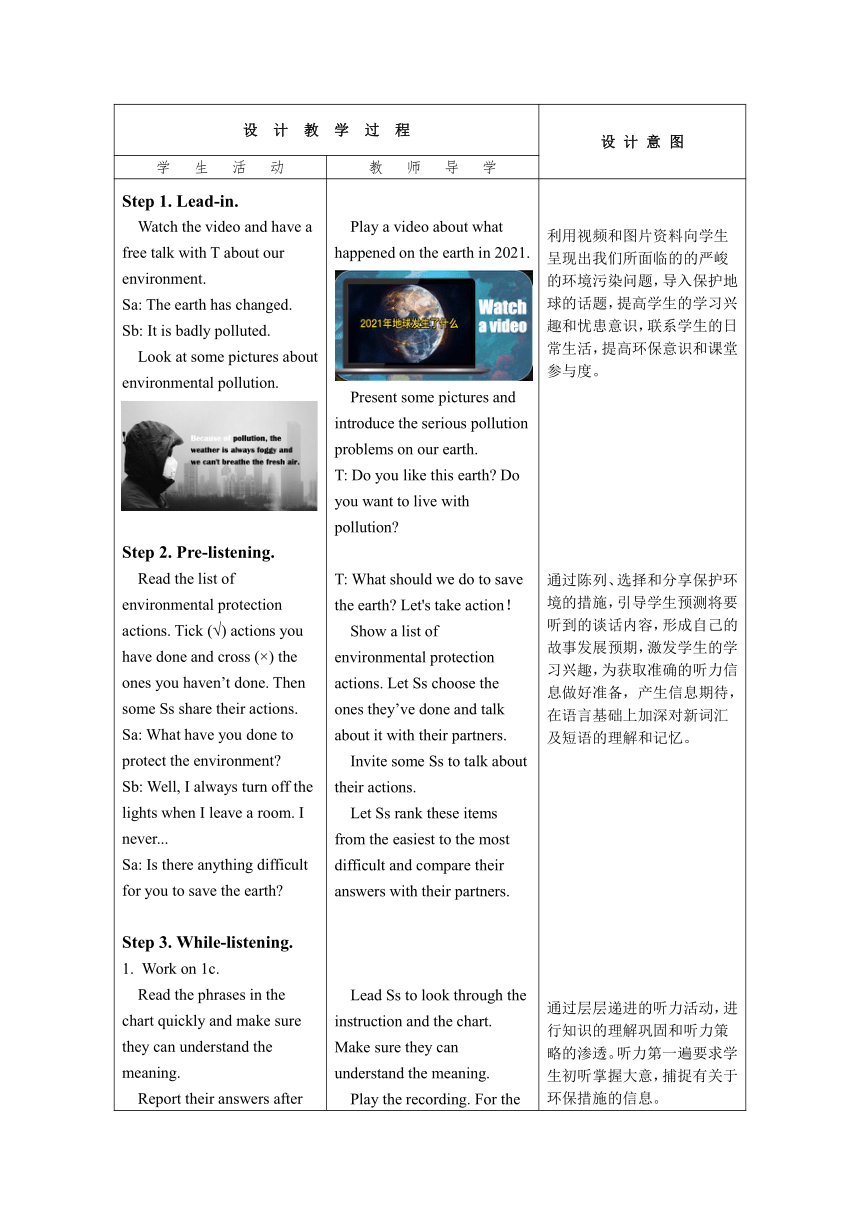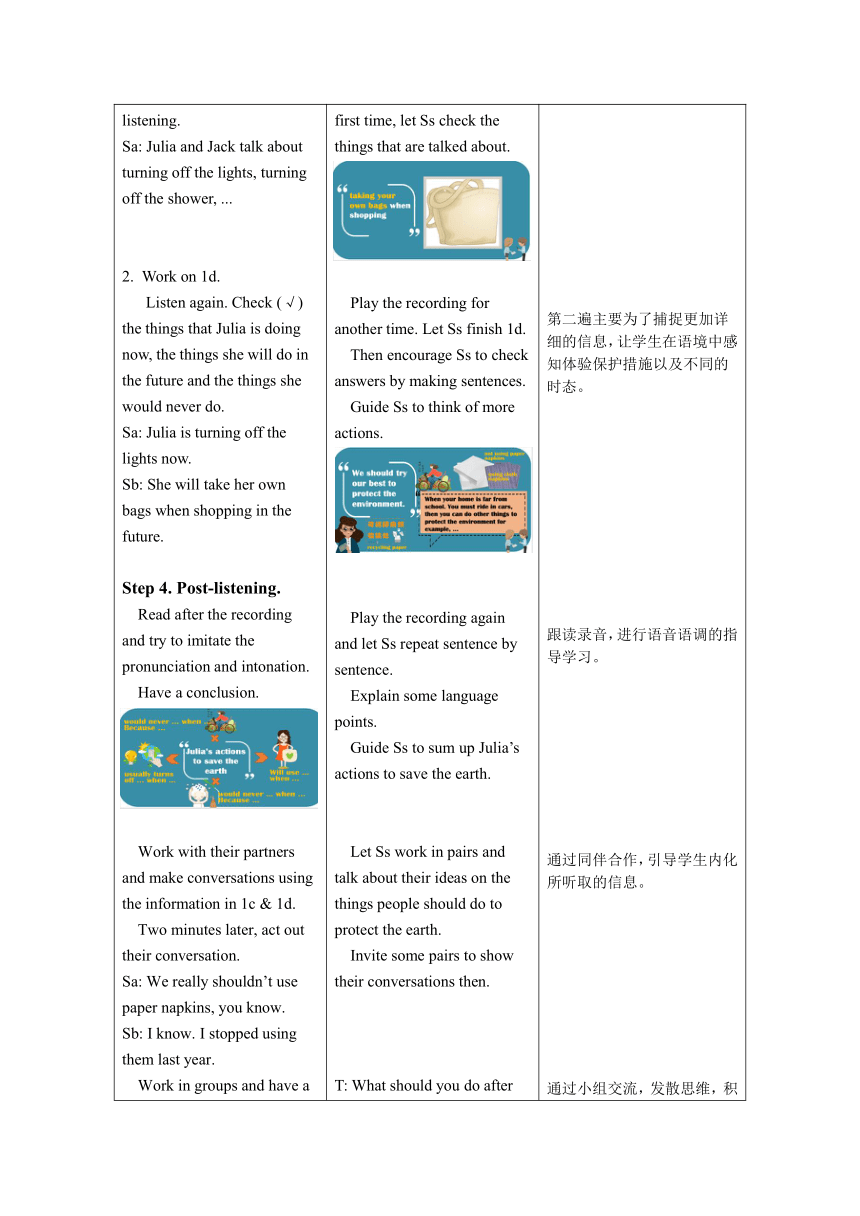【核心素养目标】Unit 13 We’re trying to save the earth! Section B (1a-1e) 表格式教案
文档属性
| 名称 | 【核心素养目标】Unit 13 We’re trying to save the earth! Section B (1a-1e) 表格式教案 |

|
|
| 格式 | docx | ||
| 文件大小 | 844.1KB | ||
| 资源类型 | 教案 | ||
| 版本资源 | 人教新目标(Go for it)版 | ||
| 科目 | 英语 | ||
| 更新时间 | 2024-09-25 16:15:22 | ||
图片预览



文档简介
课题 Unit 13 We’re trying to save the earth! Section B (1a-1e) 班级 备课教师
课型 听说课 课时 4
核心素养与思政渗透 本课时继续围绕环境保护话题展开语言实践活动,通过谈论日常生活中的个人环保措施,进一步引导学生巩固一般现在时和一般将来时的用法,从而激发学生学习英语的兴趣,促进其在语言学习中发展思维,在思维发展中学习语言,提升思维的逻辑性、批判性和创新性,另外,了解环境保护的多种方式,并增强环保意识和人类命运共同体意识,积极落实到实际行动中,增强社会责任感,引发对未来发展的思考。
课标分析 新课标要求九年级学生能听懂发音清晰、语速较慢的简短口头表达,获取关键信息;积累常用的词语搭配;在听、读、看的过程中,围绕语篇内容记录重点信息,整体理解和简要概括主要内容;能围绕相关主题,运用所学语言,与他人进行日常交流,语音、语调、用词基本正确,表达比较连贯;能初步理解人类命运共同体和全人类共同价值的概念;关爱他人,尊重他人,有社会责任感;能多角度、辩证地看待事物和分析问题;有积极主动的学习态度和较强的自信心;能主动参与课内外各种英语实践活动,注意倾听,积极使用英语进行交流。
教学目标 语言能力 能够在“拯救地球”的情境中,正确使用一般现在时和一般将来时,以听、看、说等方式,理解和谈论他人和自己日常生活中的个人环保措施;通过听前预测、听中细节获取、听后信息整合、迁移创新等途径促进听说技能的提升;
文化意识 能够了解环境保护的多种方式,并增强环保意识和人类命运共同体意识,积极落实到实际行动中,增强社会责任感,引发对未来发展的思考;
思维品质 能够在听说活动中准确获取并清晰表达有关环境保护的方式等信息,提高思维的逻辑性、深刻性和批判性;
学习能力 能够通过谈论有关环境保护的话题,保持英语学习兴趣;通过听力及口语策略的感悟、体验和学习,形成良好的学习习惯,提高学习效率;能主动参与各种英语实践活动,注意倾听,积极使用英语进行交流。
教材内容分析 本课是一节听说课,1a-1e部分主要谈论保护地球的各种方式。1a-1b是听前活动,其中1a提供了五种保护环境的方式,让学生从易到难进行排序;1b让学生与同伴比较排序结果;1c和1d是听中活动,听力呈现了Julia和Jack讨论环境保护方面的措施和做法,主要训练学生捕捉信息的能力;1e是一个半控制性的口语活动,要求学生就1c表格中的内容,讲讲自己的看法。
重点 听力策略的提升;运用现在进行时和一般将来时与同伴就日常生活中的个人环保行为对话;
难点 了解环境保护的方式,并落实到积极的行动之中;
学情分析 通过A部分的学习,学生已经熟悉了环境保护的话题,并尝试用英语对各种保护方式进行表达。在日常生活中,学生也了解一些怎样从自我做起,注意环保的措施,但还不全面,也不能完全用英语表达粗来。本课时的内容与生活密切相关,教师应引导学生积极参与,把语言学习和实际生活联系起来。
第 页
教 学 流 程
设 计 教 学 过 程 设 计 意 图
学 生 活 动 教 师 导 学
Step 1. Lead-in. Watch the video and have a free talk with T about our environment. Sa: The earth has changed. Sb: It is badly polluted. Look at some pictures about environmental pollution. Step 2. Pre-listening. Read the list of environmental protection actions. Tick (√) actions you have done and cross (×) the ones you haven’t done. Then some Ss share their actions. Sa: What have you done to protect the environment Sb: Well, I always turn off the lights when I leave a room. I never... Sa: Is there anything difficult for you to save the earth Step 3. While-listening. Work on 1c. Read the phrases in the chart quickly and make sure they can understand the meaning. Report their answers after listening. Sa: Julia and Jack talk about turning off the lights, turning off the shower, ... Work on 1d. Listen again. Check (√) the things that Julia is doing now, the things she will do in the future and the things she would never do. Sa: Julia is turning off the lights now. Sb: She will take her own bags when shopping in the future. Step 4. Post-listening. Read after the recording and try to imitate the pronunciation and intonation. Have a conclusion. Work with their partners and make conversations using the information in 1c & 1d. Two minutes later, act out their conversation. Sa: We really shouldn’t use paper napkins, you know. Sb: I know. I stopped using them last year. Work in groups and have a discussion on the things we should do. Then some Ss give speeches in class. Step 5. Conclusion. Have a summary of what we have learned with the help of T. Play a video about what happened on the earth in 2021. Present some pictures and introduce the serious pollution problems on our earth. T: Do you like this earth Do you want to live with pollution T: What should we do to save the earth Let's take action! Show a list of environmental protection actions. Let Ss choose the ones they’ve done and talk about it with their partners. Invite some Ss to talk about their actions. Let Ss rank these items from the easiest to the most difficult and compare their answers with their partners. Lead Ss to look through the instruction and the chart. Make sure they can understand the meaning. Play the recording. For the first time, let Ss check the things that are talked about. Play the recording for another time. Let Ss finish 1d. Then encourage Ss to check answers by making sentences. Guide Ss to think of more actions. Play the recording again and let Ss repeat sentence by sentence. Explain some language points. Guide Ss to sum up Julia’s actions to save the earth. Let Ss work in pairs and talk about their ideas on the things people should do to protect the earth. Invite some pairs to show their conversations then. T: What should you do after having a picnic Provide some pictures for Ss to discuss what they are supposed to do. Play the song —— Heal the World. 利用视频和图片资料向学生呈现出我们所面临的的严峻的环境污染问题,导入保护地球的话题,提高学生的学习兴趣和忧患意识,联系学生的日常生活,提高环保意识和课堂参与度。 通过陈列、选择和分享保护环境的措施,引导学生预测将要听到的谈话内容,形成自己的故事发展预期,激发学生的学习兴趣,为获取准确的听力信息做好准备,产生信息期待,在语言基础上加深对新词汇及短语的理解和记忆。 通过层层递进的听力活动,进行知识的理解巩固和听力策略的渗透。听力第一遍要求学生初听掌握大意,捕捉有关于环保措施的信息。 第二遍主要为了捕捉更加详细的信息,让学生在语境中感知体验保护措施以及不同的时态。 跟读录音,进行语音语调的指导学习。 通过同伴合作,引导学生内化所听取的信息。 通过小组交流,发散思维,积累更多有关环保措施的想法,并积极尝试用英语表达,巩固目标语言,提高口语表达能力和合作能力,同时,发挥想象力和创造力,促进学生创造性思维的发展。 总结提炼,利用英文歌曲进行情感渗透,帮助学生增强环保意识和人类命运共同体意识,增强社会责任感,积极落实到实际行动中。
第 页
课 时 达 标 检 测
Ⅰ.选择方框中的词并用其正确形式填空。 take recycle own napkin shop 1.__________ paper is a really easy thing for everyone. 2. The girl doesn’t have her ______ room. 3. She went _____________ with her sister in the supermarket yesterday. 4. My brother is ______ a shower in the bathroom now. 5. And if you have to cough, use your _______ to cover your mouth. Ⅱ.根据汉语意思完成句子,每空一词。 6. 停止做游戏真是很难。 ______ hard _____ ______ _________ games. 7. 当你在洗发时关闭水龙头。 ______ ______ the tap _______ you are washing your hair. 8. 我们真的不该用餐巾纸了。 We really _________ _______ paper napkins. 9. 去年我停止使用它们了。 I _________ _______ them last year. Ⅲ. 翻译下列句子。 10. 我使用毛巾而不是纸巾。 ________________________________ 11. 当你购物时请带自己的袋子。 _____________________________________ 12. 循环使用书本和纸张是对环境有益的。 _____________________________________ 13. 我们去年就停止使用塑料袋了。 ___________________________________ 14. 为了环境你最好骑自行车或步行。 ___________________________________
第 页
课 时 教 学 设 计 尾 页
板 书 设 计
Unit 13 We’re trying to save the earth! Section B (1a-1e)
作 业 设 计
Level A Imagine you are the crying Earth. Write a letter to call on humans to protect you and live together harmoniously.
Level B Write a short passage to introduce the things Julia is doing now, things Julia will do in the future and things Julia would never do based on 1c&1d.
教 学 反 思
第 页
课型 听说课 课时 4
核心素养与思政渗透 本课时继续围绕环境保护话题展开语言实践活动,通过谈论日常生活中的个人环保措施,进一步引导学生巩固一般现在时和一般将来时的用法,从而激发学生学习英语的兴趣,促进其在语言学习中发展思维,在思维发展中学习语言,提升思维的逻辑性、批判性和创新性,另外,了解环境保护的多种方式,并增强环保意识和人类命运共同体意识,积极落实到实际行动中,增强社会责任感,引发对未来发展的思考。
课标分析 新课标要求九年级学生能听懂发音清晰、语速较慢的简短口头表达,获取关键信息;积累常用的词语搭配;在听、读、看的过程中,围绕语篇内容记录重点信息,整体理解和简要概括主要内容;能围绕相关主题,运用所学语言,与他人进行日常交流,语音、语调、用词基本正确,表达比较连贯;能初步理解人类命运共同体和全人类共同价值的概念;关爱他人,尊重他人,有社会责任感;能多角度、辩证地看待事物和分析问题;有积极主动的学习态度和较强的自信心;能主动参与课内外各种英语实践活动,注意倾听,积极使用英语进行交流。
教学目标 语言能力 能够在“拯救地球”的情境中,正确使用一般现在时和一般将来时,以听、看、说等方式,理解和谈论他人和自己日常生活中的个人环保措施;通过听前预测、听中细节获取、听后信息整合、迁移创新等途径促进听说技能的提升;
文化意识 能够了解环境保护的多种方式,并增强环保意识和人类命运共同体意识,积极落实到实际行动中,增强社会责任感,引发对未来发展的思考;
思维品质 能够在听说活动中准确获取并清晰表达有关环境保护的方式等信息,提高思维的逻辑性、深刻性和批判性;
学习能力 能够通过谈论有关环境保护的话题,保持英语学习兴趣;通过听力及口语策略的感悟、体验和学习,形成良好的学习习惯,提高学习效率;能主动参与各种英语实践活动,注意倾听,积极使用英语进行交流。
教材内容分析 本课是一节听说课,1a-1e部分主要谈论保护地球的各种方式。1a-1b是听前活动,其中1a提供了五种保护环境的方式,让学生从易到难进行排序;1b让学生与同伴比较排序结果;1c和1d是听中活动,听力呈现了Julia和Jack讨论环境保护方面的措施和做法,主要训练学生捕捉信息的能力;1e是一个半控制性的口语活动,要求学生就1c表格中的内容,讲讲自己的看法。
重点 听力策略的提升;运用现在进行时和一般将来时与同伴就日常生活中的个人环保行为对话;
难点 了解环境保护的方式,并落实到积极的行动之中;
学情分析 通过A部分的学习,学生已经熟悉了环境保护的话题,并尝试用英语对各种保护方式进行表达。在日常生活中,学生也了解一些怎样从自我做起,注意环保的措施,但还不全面,也不能完全用英语表达粗来。本课时的内容与生活密切相关,教师应引导学生积极参与,把语言学习和实际生活联系起来。
第 页
教 学 流 程
设 计 教 学 过 程 设 计 意 图
学 生 活 动 教 师 导 学
Step 1. Lead-in. Watch the video and have a free talk with T about our environment. Sa: The earth has changed. Sb: It is badly polluted. Look at some pictures about environmental pollution. Step 2. Pre-listening. Read the list of environmental protection actions. Tick (√) actions you have done and cross (×) the ones you haven’t done. Then some Ss share their actions. Sa: What have you done to protect the environment Sb: Well, I always turn off the lights when I leave a room. I never... Sa: Is there anything difficult for you to save the earth Step 3. While-listening. Work on 1c. Read the phrases in the chart quickly and make sure they can understand the meaning. Report their answers after listening. Sa: Julia and Jack talk about turning off the lights, turning off the shower, ... Work on 1d. Listen again. Check (√) the things that Julia is doing now, the things she will do in the future and the things she would never do. Sa: Julia is turning off the lights now. Sb: She will take her own bags when shopping in the future. Step 4. Post-listening. Read after the recording and try to imitate the pronunciation and intonation. Have a conclusion. Work with their partners and make conversations using the information in 1c & 1d. Two minutes later, act out their conversation. Sa: We really shouldn’t use paper napkins, you know. Sb: I know. I stopped using them last year. Work in groups and have a discussion on the things we should do. Then some Ss give speeches in class. Step 5. Conclusion. Have a summary of what we have learned with the help of T. Play a video about what happened on the earth in 2021. Present some pictures and introduce the serious pollution problems on our earth. T: Do you like this earth Do you want to live with pollution T: What should we do to save the earth Let's take action! Show a list of environmental protection actions. Let Ss choose the ones they’ve done and talk about it with their partners. Invite some Ss to talk about their actions. Let Ss rank these items from the easiest to the most difficult and compare their answers with their partners. Lead Ss to look through the instruction and the chart. Make sure they can understand the meaning. Play the recording. For the first time, let Ss check the things that are talked about. Play the recording for another time. Let Ss finish 1d. Then encourage Ss to check answers by making sentences. Guide Ss to think of more actions. Play the recording again and let Ss repeat sentence by sentence. Explain some language points. Guide Ss to sum up Julia’s actions to save the earth. Let Ss work in pairs and talk about their ideas on the things people should do to protect the earth. Invite some pairs to show their conversations then. T: What should you do after having a picnic Provide some pictures for Ss to discuss what they are supposed to do. Play the song —— Heal the World. 利用视频和图片资料向学生呈现出我们所面临的的严峻的环境污染问题,导入保护地球的话题,提高学生的学习兴趣和忧患意识,联系学生的日常生活,提高环保意识和课堂参与度。 通过陈列、选择和分享保护环境的措施,引导学生预测将要听到的谈话内容,形成自己的故事发展预期,激发学生的学习兴趣,为获取准确的听力信息做好准备,产生信息期待,在语言基础上加深对新词汇及短语的理解和记忆。 通过层层递进的听力活动,进行知识的理解巩固和听力策略的渗透。听力第一遍要求学生初听掌握大意,捕捉有关于环保措施的信息。 第二遍主要为了捕捉更加详细的信息,让学生在语境中感知体验保护措施以及不同的时态。 跟读录音,进行语音语调的指导学习。 通过同伴合作,引导学生内化所听取的信息。 通过小组交流,发散思维,积累更多有关环保措施的想法,并积极尝试用英语表达,巩固目标语言,提高口语表达能力和合作能力,同时,发挥想象力和创造力,促进学生创造性思维的发展。 总结提炼,利用英文歌曲进行情感渗透,帮助学生增强环保意识和人类命运共同体意识,增强社会责任感,积极落实到实际行动中。
第 页
课 时 达 标 检 测
Ⅰ.选择方框中的词并用其正确形式填空。 take recycle own napkin shop 1.__________ paper is a really easy thing for everyone. 2. The girl doesn’t have her ______ room. 3. She went _____________ with her sister in the supermarket yesterday. 4. My brother is ______ a shower in the bathroom now. 5. And if you have to cough, use your _______ to cover your mouth. Ⅱ.根据汉语意思完成句子,每空一词。 6. 停止做游戏真是很难。 ______ hard _____ ______ _________ games. 7. 当你在洗发时关闭水龙头。 ______ ______ the tap _______ you are washing your hair. 8. 我们真的不该用餐巾纸了。 We really _________ _______ paper napkins. 9. 去年我停止使用它们了。 I _________ _______ them last year. Ⅲ. 翻译下列句子。 10. 我使用毛巾而不是纸巾。 ________________________________ 11. 当你购物时请带自己的袋子。 _____________________________________ 12. 循环使用书本和纸张是对环境有益的。 _____________________________________ 13. 我们去年就停止使用塑料袋了。 ___________________________________ 14. 为了环境你最好骑自行车或步行。 ___________________________________
第 页
课 时 教 学 设 计 尾 页
板 书 设 计
Unit 13 We’re trying to save the earth! Section B (1a-1e)
作 业 设 计
Level A Imagine you are the crying Earth. Write a letter to call on humans to protect you and live together harmoniously.
Level B Write a short passage to introduce the things Julia is doing now, things Julia will do in the future and things Julia would never do based on 1c&1d.
教 学 反 思
第 页
同课章节目录
- Unit 1 How can we become good learners.
- Section A
- Section B
- Unit 2 I think that mooncakes are delicious!
- Section A
- Section B
- Unit 3 Could you please tell me where the restroom
- Section A
- Section B
- Unit 4 I used to be afraid of the dark.
- Section A
- Section B
- Unit 5 What are the shirts made of?
- Section A
- Section B
- Review of Units 1-5
- Unit 6 When was it invented?
- Section A
- Section B
- Unit 7 Teenagers should be allowed to choose their
- Section A
- Section B
- Unit 8 It must belong to Carla.
- Section A
- Section B
- Unit 9 I like music that I can dance to.
- Section A
- Section B
- Unit 10 You're supposed to shake hands.
- Section A
- Section B
- Review of Units 6-10
- Unit 11 Sad movies make me cry.
- Section A
- Section B
- Unit 12 Life is full of the unexpected
- Section A
- Section B
- Unit 13 We're trying to save the earth!
- Section A
- Section B
- Unit 14 I remember meeting all of you in Grade 7.
- Section A
- Section B
- Review of Units 11-14
